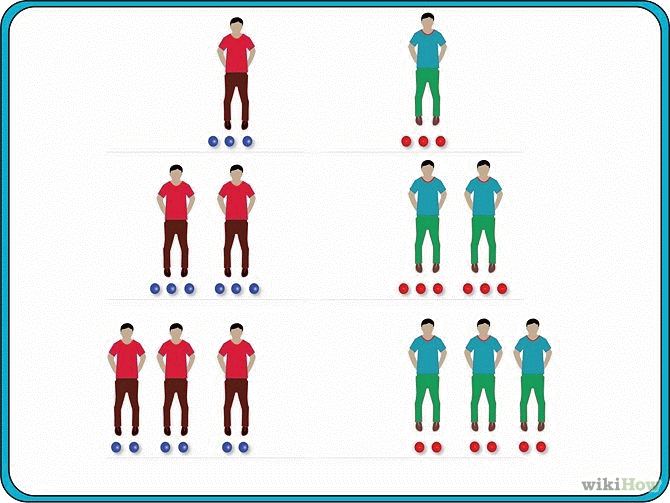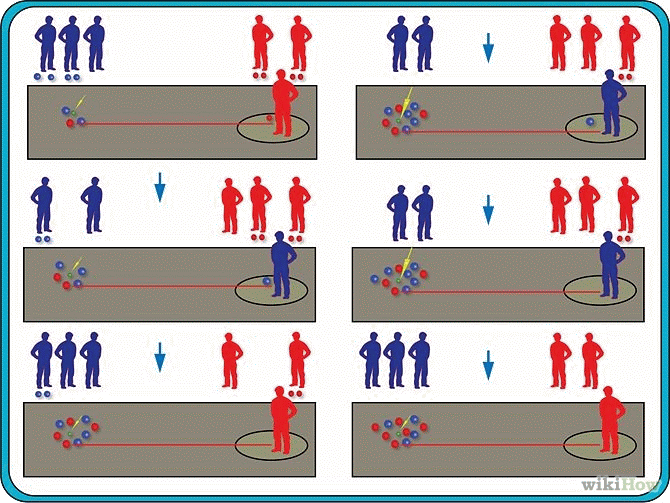II.1.1. Main rules
Playing area
Pétanque can be played on all kinds of grounds, it does not need a dedicated field. Any level ground in the yard, playground or in a park composed of either sand or clay is suitable. However, the competitive sport has certain specifications regarding the size and weight of the boules, the playing area and the rules. Official matches are played on an area marked by the organizer or the committee of the referees. In this case the dimensions of the pitch are 3-4 m wide and 12-15 m long.
The boules
Pétanque boules are made of metal, with a minimum of 70.5 mm and a maximum of 80 mm in diameter and a weight between 650 and 800 g.
The ball of contrasting colour called „the jack” („cochonnet” in French) is made of wood or plastic and is 30 mm in diameter. Boules are made easier to distinguish by engravings of patterned grooves, identification codes and trademarks.
Leisure boules cost about 10 dollars per 3 pieces, while professional, rustproof ones that come with identification marks cost 100 dollars per 3 pieces and are available in bigger sports equipment stores. National and international tournaments require competition boules. Boules are usually sold with the jack. There are extra accessories like boule lifter magnet, jack case, pocket scorer. In order to avoid conflicts, it is practical to use measuring devices, and during matches, referees and scoreboards shall be provided.
(http://www.petanqueklub.eoldal.hu/cikkek/petanque-tortenete.html)
Gameplay elements
A game begins with a coin toss to determine which team plays first, that is, which one throws the jack. The jack must be thrown to a distance of 6-10m from the circle. The objective is to throw the boule as close as possible to the jack. Any method is permitted: it is allowed to roll, to lob and to throw the boule, as well. Feet have to be inside the circle without crossing its line. Circle must not be left until the boule touches the ground. Feet must not be lifted up from the ground. If a player with wheelchair throws, one wheel of the wheelchair has to be inside the circle.
There are two different tactics. One objective of a throw can be to make the boule rest in a particular spot, as close as possible to the jack. The other objective is to knock an opponent’s boule away from the jack. The latter can be dangerous because a player may see his/her boule get farther than the opponent’s one. Experienced players try to observe which distance is the weakness of the opponent, then try to throw the jack there. The team that has the worse result throws the next boule until it runs out of boules. At the end, the team with the closest boule receives one point for each of its boules that is closer to the jack than the other team's closest boule. Whichever team scores 13 points first wins.
(http://vakbarat.magyarnarancs.hu/sport/petanque_-_haho_ocsi-68843)
Composition of teams
- 3 players against 3 players (triplettes- triples)
- 2 players against 2 players (doublettes- doubles)
- 1 player against 1 player (tête-à-tête- singles)
In triples, each player uses only two metal boules. In the singles and doubles games, each player uses three metal boules. No other formula is allowed.

Gameplay in the video below:
https://www.youtube.com/watch?v=5s9BpxOsOY4#t=27
The game
- Once the jack is thrown, the player attempts to throw the boule so that it lands as close to the jack as possible (it can touch or even push it).
- A player from the other team then throws their boule, trying to place it closer to the cochonnet than their opponent, or to knock the opponent’s boule away.
- The players in the losing team play until they get the lead. The player that does not score a point keeps on playing until they receive that point. This can be achieved by attempting to replace the boule he lost with another one of his boules.
- When a team runs out of boules, the players of the other team plays theirs.
- When neither of the teams have boules, they stop and count the points. The winning team scores one point for each boule nearer the cochonnet than the opponents closest.
- A player from the team that has won throws the cochonnet again. The winners are the first team to reach 13 points.

(http://www.wikihow.com/Play-Petanque)
Petanque competition in the video below: